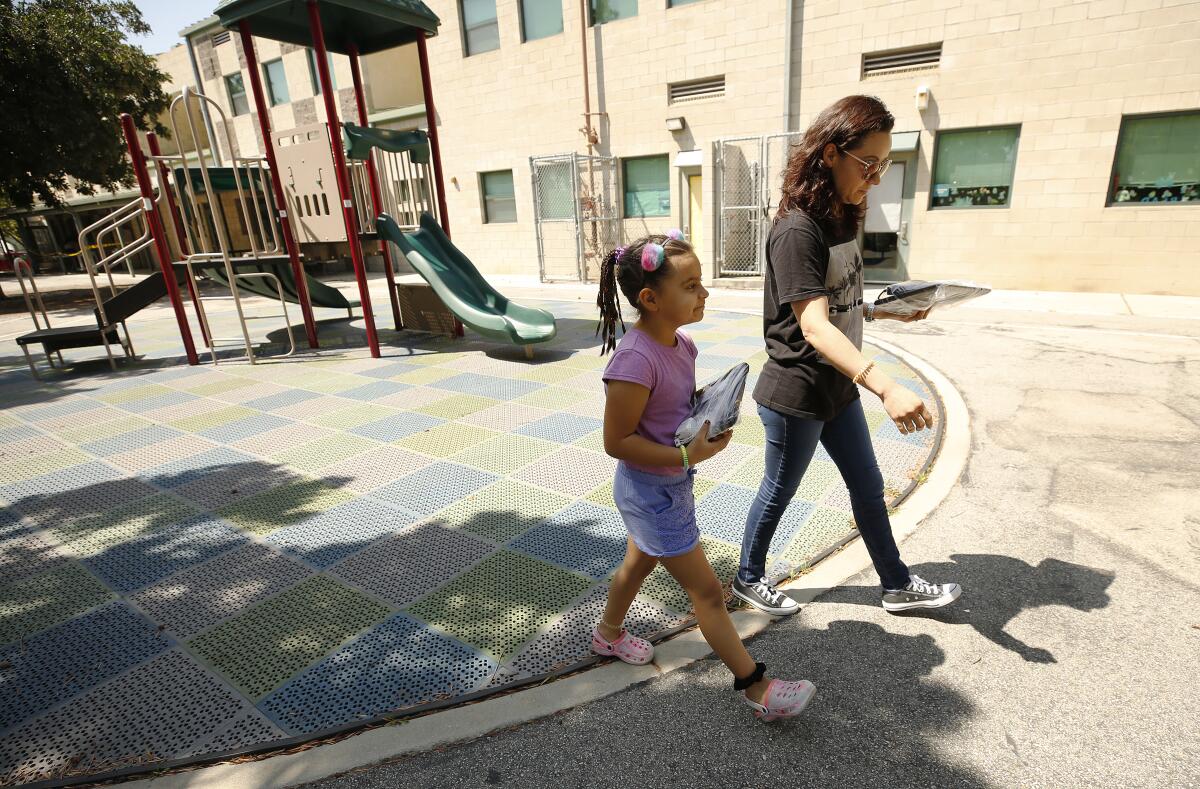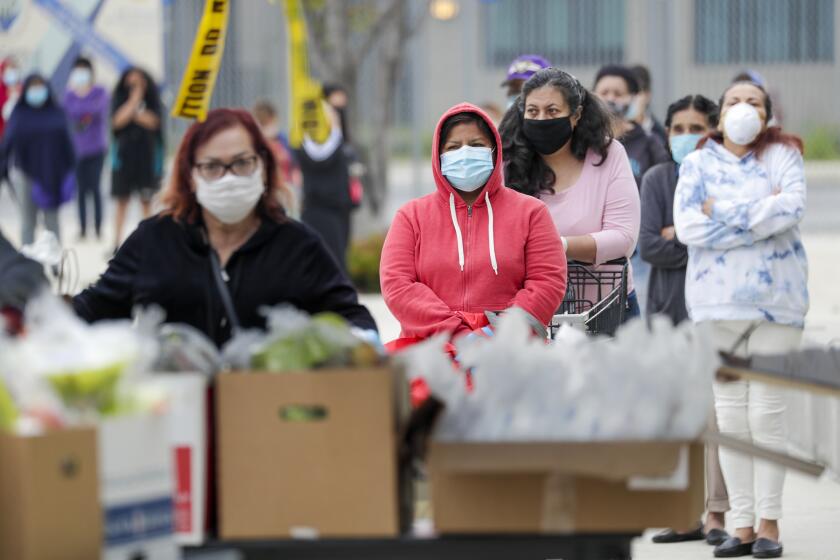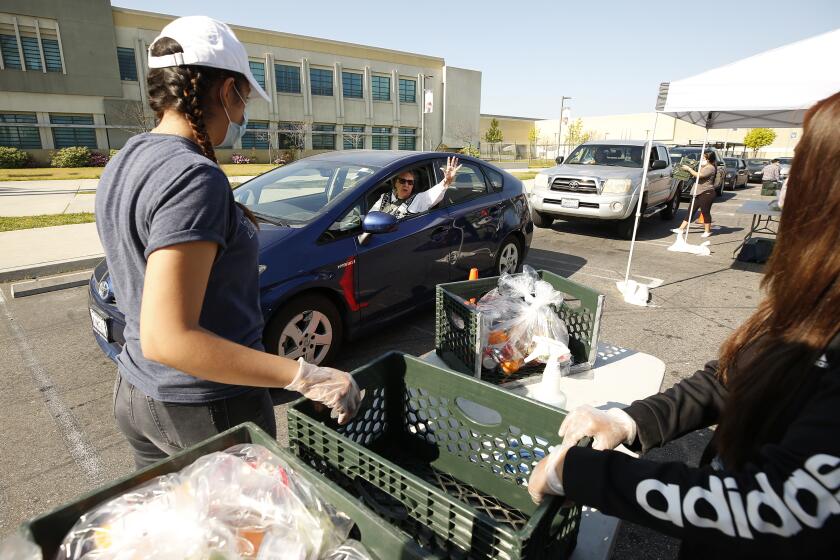Getting free internet is hard for poor students despite provider promises, survey finds

- Share via
Tamara Solis faced a choice when it came to her children’s education: Pay for rent and food or pay for internet access. Broadband came in second, so she takes her kids to a friend’s garage apartment in Watts for internet — where they do their schoolwork in close quarters amid the coronavirus pandemic.
“It’s a small place,” said Solis, noting that it was difficult to abide by recommended physical distancing guidelines. “We try to do the best — one on the table, one on the sofa, one on the bed ... but it’s not big enough to keep far away.”
Her plight is not unique.
Despite promises of help, families in the low-income neighborhoods of Watts, Boyle Heights and South Los Angeles have struggled to get online, with at least 16% of students lacking basic internet access, according to a survey of public school families in those communities released Wednesday by the nonprofit Partnership for Los Angeles Schools.
Many more students likely lack the high-speed internet connection needed for regular online academic work, according to the organization, which manages 18 L.A. Unified campuses that enroll large numbers of black and Latino students who are members of low-income families.
The survey, conducted March 24 through April 4, also recorded other areas of concern: 15% of families reported that students had not yet been in contact with teachers, and 25% said students needed to print out materials at home for their assignments, but they lacked a printer.
The Los Angeles school district racks up $200 million in emergency coronavirus costs, from meal programs to computers, and the budget outlook is uncertain at best.
Partnership staff interviewed the families of more than 1,000 students about their experience with service providers and also initiated requests for service from addresses in Watts, which is served by Partnership schools.
Families from among the city’s most impoverished neighborhoods report impediments to signing up for free service offered as aid during coronavirus-related school closures. The difficulties included inadequate coverage areas in their communities, long wait times, limited data plans and unexpected fees and documentation requirements, as well as monthly payments that were too costly to sustain after a free period.
Companies represented in the survey — AT&T, Charter Spectrum, T-Mobile and Verizon — defended their efforts, saying they moved to offer their services during this time of school closures to help the families of low-income students. They explained that coverage limitations are based on geography or other factors, and noted that customers can cancel in order to avoid monthly fees after their free service expires.
“We are committed to supporting families who need internet access during this difficult time,” said Jim Kimberly, an AT&T spokesman.
The free service is typically scheduled to end near the close of the current school year — although the internet needs of families are expected to extend well beyond that.
The Los Angeles Unified School District is trying to fill the digital gap by providing students with portable internet hot spots and computers. But the district has not not yet been able to reach all who need the devices.
Coronavirus: While food banks struggle, L.A.’s schools are feeding the hungry
Campuses across the state have been closed since mid-March, forcing students to continue academic work through “distance learning.” In most cases, that means receiving, completing and submitting assignments online and taking part in online sessions through platforms such as Zoom.
“Education is a constitutional right in California,” said Ryan Smith, chief external officer of the Partnership for L.A. Schools. “However long we’re doing online learning then internet connection must become a constitutional right, too. Therefore we must monitor the ‘free trials’ that these internet companies are trying to provide.”
Smith generally praised L.A. Unified’s efforts to fill the digital gap, noting that more families were becoming aware of the district-provided hot spots as the survey proceeded. He said he was less impressed with offers by the technology companies.
AT&T
Survey findings: Most callers were not told that a free trial is available. The few who were told about the trial had to sign up for a $59.99 per month plan to receive the first 60 days free of charge.
Response: The company is committed to providing two months of free service to eligible families and they do not have to sign up for a $59.99 plan. Families eligible for free service include those with children who qualify for the subsidized school lunch program and Head Start preschool.
Charter Spectrum
Survey findings: No home service was available in most of Watts’ 90002 ZIP Code. The free trial required signing up for a $54.99 per month plan after the no-cost 60 days.
Response: Spectrum is available in the areas covered by the survey. However, some renters in multiunit buildings may not be able to access services if Spectrum does not “have an agreement with the property owner to wire the building and serve residents.” Customers can cancel at any time.
T-Mobile
Survey findings: No home internet service is provided in the communities that were part of the survey. Existing customers pay an additional $15 a month for a hot spot with 2 gigs of high-speed access, which is not enough for students and families, according to the Partnership.
Response: The company has created options for customers to receive extra data — at no extra charge — but these offers do not include free service. The company also introduced a plan priced at $15 per month.
Verizon
Survey findings: No home internet service was available in the survey area. Separately, L.A. Unified is paying for hot spots that are free for students. Families who directly contacted Verizon were referred to L.A. Unified. Families unaware of the district arrangement were advised by Verizon representatives to use a public hot spot.
Response: Verizon provides home internet service in limited parts of L.A., but not Watts. The arrangement with L.A. Unified is that the district — not Verizon — distributes the hot spots to families.
For Solis, the online odyssey included burning through the 10 gigabytes of hot-spot data she was able to obtain through T-Mobile in about two weeks — online schoolwork for her two children can consume a lot of data, she said. She tried unsuccessfully to get free Wi-Fi service from Spectrum and AT&T to her Watts home.
Solis is out of work after an injury last year, and her husband is getting only part-time hours now as a maintenance worker.
“Money for the internet — it’s not in my plans right now,” Solis said. “They said, ‘It’s going to be free’ ... and it’s not free.”
So far, she also has not been able to get a hot spot from Florence Griffith Joyner Elementary, a Partnership school in Watts. Portable hot spots recently arrived at the school, and administrators are currently reaching out to families who might need them, said Cathy Kralik, a spokeswoman for the Partnership.
A Spectrum spokesman said Solis should qualify for its special offer.
The survey represents a snapshot in time and, since then, the situation has improved as L.A. Unified continues to distribute technology and as teachers and students engage more effectively, district officials said Tuesday.
L.A. Unified Deputy Supt. Megan Reilly said she appreciated receiving the information about lack of access to printers. “That was not on our radar,” she said.
She added that the distribution of devices has been slowed by the necessary logistics of installing bar codes, the district’s online learning management system and software that keeps students safe online while also allowing for central updates.
The district prioritized getting computers to high school students, then turned to middle schools. Elementary students went home with work packets, but the effort is underway to provide them with technology as well.
The district’s latest data indicate that, overall, 98% of high school students and 97% of middle school students had logged on at least once by April 17, figures that represent substantial progress. However, 7% of high schoolers were not in contact with teachers every week.
“There are challenges in the field,” said Pedro Salcido, chief of staff to L.A. Unified Supt. Austin Beutner. “We have been pretty aware of them. Even in a non-COVID-19 world this would be a big lift logistically.”
Solis said she has come to realize the sudden importance of digital access to her children’s education.
“Everything is by computer — everything,” she said. “So that’s one thing I realize right now: that I have to have internet.”
More to Read
Sign up for Essential California
The most important California stories and recommendations in your inbox every morning.
You may occasionally receive promotional content from the Los Angeles Times.
















